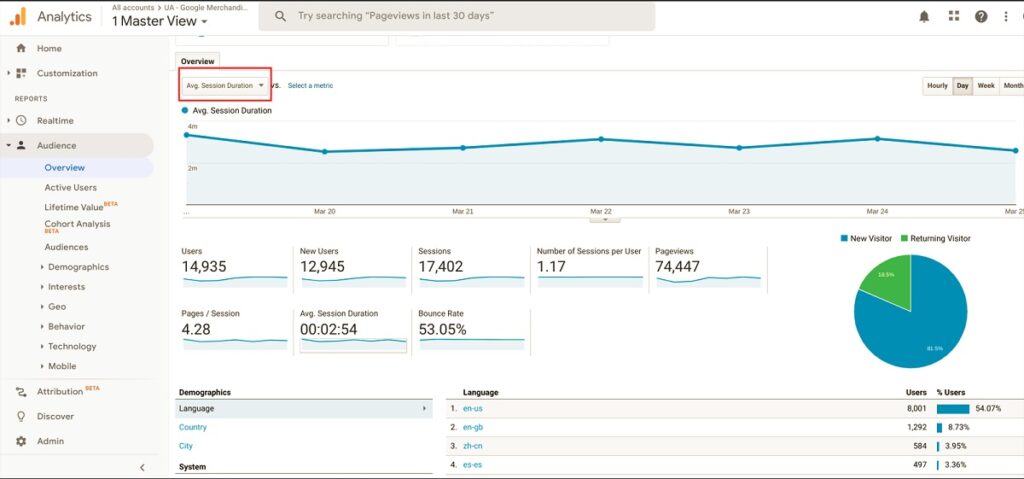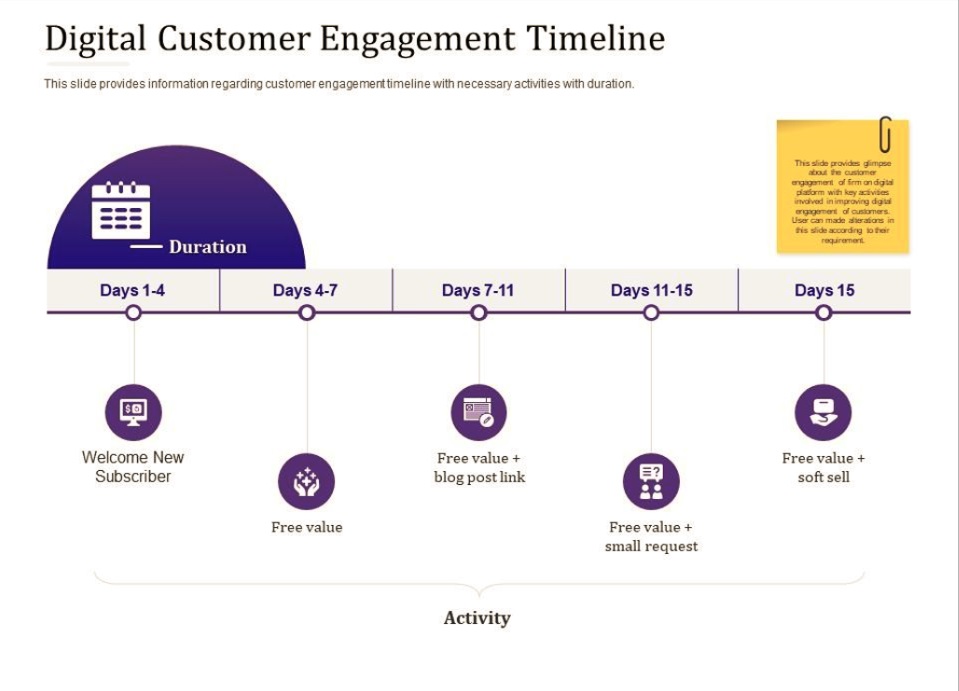user engagement metrics
Pageviews
Benefits:
Pageviews, a fundamental user engagement metric, offer a wealth of insights. The higher the number of page views, the higher the website’s traffic, the more successfully it has implemented SEO techniques, and the more people are interested in its content.
This understanding can guide your content strategy and SEO efforts with confidence. It can show the trend of user interests and help solve problems with improper content strategy, such as publishing irrelevant or low-quality content.
Drawbacks:
However, it’s important to note that many impressions – and, in the first place, high pageviews – do not always translate into user satisfaction or conversion. They merely indicate that users are present.
This cautionary note ensures a balanced perspective on this metric. Sometimes, it can be challenging to know if users are gaining something out of the content provided.
Time on Page | User Engagement Metrics
Benefits:
As indicated by the time-on-page metric, more time spent on a particular page implies that the user is interested in the information provided and is more likely to read the content provided on the page.
This reassurance in the metric’s value can guide your content creation and optimization strategies. Help to focus on the most popular kinds of content and their formats.

Drawbacks:
- Lacks passive activity; a user can leave a webpage open without reading the content.
- It lacks other measures that can be used to complement the satisfaction and effectiveness of users’ goals.
Bounce Rate | User Engagement Metrics
Benefits:
- To help identify pages, ‘bounce rates’ reveal the proportions of visitors who run off after viewing only a single page.
- It can help direct the content structure and internal linking about services.
Drawbacks:
- Of course, this is not a good sign if users are having problems finding what they are looking for because they need to click more to get there.
- Some outside factors can skew bounce rates, such as the time to load a page.
Conversion Rate | User Engagement Metrics
Benefits:
- It can be used to directly quantify the costs of a page in terms of how well it prompts desired actions, such as form submission or purchase.
- It is essential to the assessment of marketing strategies and their profitability.
Drawbacks:
- Outside elements, such as price and other competitors, can affect the outcome in addition to the material’s content.
- As a result, this approach has higher demands for goal definition and tracking setup.
Sessions per User | User Engagement Metrics
Benefits:
- Describing how frequently users turn to a site, these are pivotal to evaluating sustained usage and loyalty.
- It may assist in defining content that attracts multiple visits to the site.
Drawbacks:
- Lacks ability to differentiate sessions by their quality; high number of sessions could be caused by unsatisfactory initial searches.
- Quantitative data is needed to know the reasons why users come back.
Click-Through Rate (CTR)
Benefits:
- High CTR entails creating good headlines and meta descriptions to lure search engines’ or newsletters’ clicks.
- It is ideal for conducting experiments with the promotional material.
Drawbacks:
- High CTR with low conversation points more often to a mismatch between the expectation created by the CTR and what is delivered.
- Lacks corresponding measures for clients to gain an understanding of value-added after click.
Scroll Depth
Benefits:
- I have to draw information about any site’s content, where users will likely find it interesting, and where their interest could be recovered.
- It can assist in making the right choices concerning the arrangement of text and images on a page to increase people’s interest.
Drawbacks:
- Even though it may be pretty apparent to some people that a high scroll depth simply means that people are only scrolling through content instead of reading through it.
- It must be used with other engagement statistics to understand the content performance.
Average Session Duration | User Engagement Metrics
Benefits:
It concerns the level of activity of all the users in all the different website pages under consideration.
More time spent on the site corresponds to the site’s exciting content and structure.
Drawbacks:
- A high average session refers to the time users might spend searching for specific information.
- To be properly quantified, it must be cross-referenced with other context and related metrics, such as conversion rates.
Exit Rate | User Engagement Metrics
Benefits:
- It assists in knowing the pages that users tend to bounce from and can help analyze whether this is due to problems with content, functionality, or design.
- It is helpful in the sense that it indicates areas of the user journey that could be improved in terms of the efficiency of conversion funnels.
Drawbacks:
- High exit rates are only sometimes alarming; many pages, such as thank you pages, have high ‘exit’ rates.
- This index should be assessed according to the current stage of the user journey and the extent to which it favours achieving the goal at hand.
User Retention Rate
Benefits:
- It helps to find the percentage of constant visitors, showing users’ appreciation of the content.
- It is crucial for organizations that deal with clients in a way that requires continuous connection.
Drawbacks:
- Lacks information regarding why repeat; perhaps quantitative information only might be required.
- A lack of new users while maintaining a high retention rate could be unsustainable in the long run.
Interaction Rate
Benefits:
- Indicates the extent to which the visitors browse and participate in filling in the forms, buttons, or multimedia objects.
- It facilitates understanding which of the features provided to users will be most engaging to them.
Drawbacks:
- Some users fail to complete the user journey, which is why touch points without conversion signify a lack of user journey.
- When there are too many interaction points, the user may get frustrated if they are not integrated into the user process.
Social Shares
Benefits:
- Getting high counts on social share can translate to improved visibility and traffic, which, at the slightest level, enhances SEO.
- It suggests the actual quality of the content and helps to make it popular, so its promotion is done organically.
Drawbacks:
- High shares but low on-page engagement signals might have articles rich in shares, but the actual articles don’t provide much engaging content.
- It is not directly changeable like links or keywords; it relies on the actual content to make people act.
First-Time Visitor Depth
Benefits:
- This is a way to estimate how far down into the site a first-time visitor will go, thus predicting the immediately engaged audience.
- Proper for fine-tuning landing pages and initial content that appears to the users when they visit the site.
Drawbacks:
- While the high depth of entry would be advantageous, it may be counterproductive if the content floods new visitors, who will be overwhelmed as they study the concept.
- It should be used in balance with effective navigation so as not to make sure the new customers understand.
Customer Satisfaction (CSAT) Scores
Benefits:
- Performance feedback from the users is useful for ascertaining user satisfaction and is essential for establishing service quality.
- It can be employed to optimize content with real users’ feedback.
Drawbacks:
- It includes user participation and is therefore limited in the amount of data that can be processed.
- Because the interpretations are pretty subjective, users may not agree with one another.
Mobile Engagement Metrics
Benefits:
- Understanding mobile users and their conduct is significantly helpful for mobile applications’ responsive design and UX design.
- It stresses making the content accessible across multiple devices, and they make it more engaging.
Drawbacks:
- Mobile engagement may give a false picture of what happens on the desktop.
- One thing to remember when optimizing a site is that mobile and desktop needs must be addressed simultaneously.
Click Path Analysis
Benefits:
- Provides information that defines the path users usually go through within the site.
- Recognition of features and possible impediments to the user flow is crucial for navigation.
Drawbacks:
- Click sequences can also define complicated paths, which can mean confusion and excessive reliance on navigation tools.
- It has to be highly dependent on accurate analytical tools to monitor and analyze performance.
Goal Completion Rate
Benefits:
- Quantifies the number of people that interact with the website in a specific way to achieve a given activity, which can be downloaded as a form or any other similar activity.
- It is very connected with conversion rates and helps judge the efficiency of the marketing approach used.
Drawbacks:
- It is better to be clear about objectives to avoid confusion by numbers; it entails proper framing.
- It may be due to factors such as the following: The quantitative measures would be more influenced by non-website operational issues through completion rates that are more representatively skewed.
Frequency and Recency
Benefits:
- Metrics such as frequency refer to the number of times customers revisit or the time taken to return.
- Helpful in tracking and (precisely) segmenting both loyal and non-loyal users for engagement strategies.
Drawbacks:
- The rationale is that high frequency but low engagement could infirm real-time and meaningful interactions with the website.
- It depends on other parameters to believe what the user essentially wants.
Heatmaps | User Engagement Metrics
Benefits:
- Drawing of the locations the user interacts with on a page or representation of the focus areas on a page.
- Enhances the layout by best revealing the areas where many users’ attention is given and where little attention is given.
Drawbacks:
- It can negatively emphasize interactions without knowing why they are taking place.
- It should be used with other figures of merit to obtain a detailed assessment of the results.
User Feedback and Surveys: User Engagement Metrics
Benefits:
- Gives direct clues on the users’ perception and their level of satisfaction.
- We may be able to suggest content and design modifications based on actual users’ reactions.
Drawbacks:
- A disadvantage of self-administered questionnaires is that response rates can be low, which may require better reliability of the resulting data.
- Feedback could come from a few users or may be skewed towards a particular group of users.
Form Completion Rate | User Engagement Metrics
Benefits:
- Records how often users finish forms, which is necessary for leads and data acquisition.
- It helps define the form’s usability and popularity and contributes to proper design changes.
Drawbacks:
- External factors, such as the focus on security, might explain the comparatively low completion rates.
- It demands a precise synchrony between the amount of information requested by the users and their desire to provide the data in question.
In-Page Engagement | User Engagement Metrics
Benefits:
- It counts contacts with individual page aspects, such as videos or any tools that might be included.
- Identify which gathers the most attention from users and their further engagement.
Drawbacks:
- Engaging content does not necessarily mean achieving site broad engagement if the other part of the page is disengaging.
- It needs to be more accurate to determine the extent to which needs are congruent with conversions.
Traffic Sources | User Engagement Metrics
Benefits:
- It helps one know the users’ source and thus can market their product using sources that bring the clients.
- Assists in identifying the channels potentially bringing in the most helpful traffic.
Drawbacks:
- If a source becomes unstable, so does the traffic of a given site if all the needed traffic is drawn from one source.
- It needs constant monitoring to adapt to trends when acquiring new users.
Video Engagement Metrics
Benefits:
- With play rate, watch time and completion rate, unique tools for evaluating the performance of the video content.
- We notify the changes in the video length and content to keep the user’s interest in mind.
Drawbacks:
- It needs a high content load; considerable resources can be spent on videos, but only some people will watch them.
- Demographic targets use it, but it thrives with some and is unsuccessful with others.
New vs. Returning Users | User Engagement Metrics
Benefits:
- It separates new users’ engagement from users who have returned to the site after some time, which helps formulate the content strategies.
- It helps analyze retention and acquisition performances, which are critical keys to a growth strategy.
Drawbacks:
- Achieving balance is required; increasing new users without extending the ability to retain those members will quickly translate to low site traffic.
- Specific measures are needed to cultivate new clients out of the periodic ones.
Practical Steps for Implementing These Metrics
Set Clear Goals | User Engagement Metrics

Practical Steps:
- Define Your KPIs: Determine which user determines which is significant to accomplish, such as growth.
- Benchmark Current Performance: To set meaningful and achievable goals, one must first examine current affairs using tools like Google Analytics.
Utilize Advanced Analytics Tools
Metrics to Address: Web analytic factors that shall be considered include the number of times the page is viewed, the time spent on the page, and the bounce rate.
Tools to Use:
Google Analytics: Track detailed traffic measures such as the number of hits per page, the tendency of bounce rates, average session time, and the origins of the traffic. Learn how to set up custom reports according to your goals.
Steps:
Install Tracking Code: Begin tracking by inserting Google Analytics tracking code at the base of all website pages.
Create Custom Dashboards: Optimize how you view dashboards depending on which form of engagement you want to track among users.
Analyze Traffic Sources: Determine which ones are organic, referral and social and see that you assess your bounce rates and session length.
Conduct Regular Reviews
Metrics to Address: Exit Rate, Goal Completion Rate, Conversion Rate
Steps:
- Review Monthly: Make it a routine to check your dashboards to see how performance has changed over time.
- Identify Patterns: Seek patterns that repeatedly lead to issues, such as differentials in the exit rates on specific landing pages.
- Adjust Strategies: If the exit rate is high on a specific page, reviewing the content and CTA and applying better policies is time.
Use of user feedback and testing
Metrics to Address: Responses from the users or customers, Timetime taken responses from timed website Heatmout apps.
- Tools and he out forms, and jar: This, rates heat maand jar: These are users’ responses from Net Promoter Score questionnaires and other on-site polls.
Steps:
Set Up Heatmaps: Hotjar UK displays activity flows that include where users are clicking or scrolling, including A/B click or scroll CTAs used for website or blog scrolling forms with higher completion rates.
Collect Feedback: Suggest the application of short questionnaires requesting feedback or problems users face.
Optimize for Mobile and Desktop
Metrics to Address: Mobile Engagement Metrics Bounce Rate
Tools to Use:
- Google Mobile-Friendly Test: Your site must be accessible and display well when a mobile device opens.
Steps:
Responsive Design: Ensure that your website is or will be easily viewable and navigable on any screen size.
Test Mobile Performance: Go to Google’s Mobile-Friendly Test to find possible additional changes that may be done to your out what additional changes your website what further changes your website may need to make to decrease tUse GTmetrix’s tools to come up with the best both the mobile and desktop improve experience for both mobile and Video Engagement Metrics
Tools to Use:
Wistia: To monitor granular video viewing metrics, including play rates and watch time.
Steps:
Embed Videos Thoughtfully: Place videos where they make the most sense to users of your website.
Analyze Engagement: Engage your subscribers with exciting videos and learn their interests using the Wistia feature.
Iterate Content: The viewer attention rate can be used to create better content by creating content that engages more visually in areas of great attention.
Integrengagesedia
Metrics to Address: in Screateial Networks, Visitors’ Sources
Tools to Uengages: To modulate and monitor thin e-sharing on social media.
Steps:
Add Social Sharing Buttons: Ensure that it is convenient for the visitor to share the content with his friends, followers, or connections on social networks.
Monitor Social Traffic: It is also used to evaluate traffic and level of engagement.
Refine Strategy: Coordination of efforts to high-impact content types and channels to increase traffic and interactions.
Optimize Content Strategy Employing LSI Keywords
Steps:
- Keyword Research: You can also check Ahrefs or SEMrush for LSI keywords with high search volumes and low competition.
- Content Optimization: Use these keywords where possible, but avoid the temptation to overstuff these words across the web pages that you want to rank higher. This will enable the sites to gain higher relevancy.
- Monitor Impact: Monitor the rankings of your site in the search engines, and then revise the keyword usage based on the metrics achieved.
Optimize the Qualiyour site’s ranking content.
Metrics to Addr and revised Duration, Bounce Rate
Steps:
- Analyze Content Performance: One should use Google Analytics to determine top content materials and duplicate the best features on the other pages.
- Focus on Topic Relevance: To determine the best topics to write about, try using BuzzSumo to get content ideas based on what is trending in your area of specialization.
- Regular Updates: Ensure that there is constant posting of new articles and enhancing the existing articles to be up-to-date.
- Improve the Site Map and Site Navigation
- Metrics to Adnew articles are constantly posted, and existing articles are enhanced with the proper arrangement of concepts and transparent menus for navigating through the site.
- Use Breadcrumbs: Use breadcrumbs so that visitors can follow your steps and move around your website.
- Conduct Usability Testing: You can use UserTesting to learn how users navigate your site.
Optimize Call-to-Actions (CTAs)
Metrics to Address: It includes Achievement of Goals, Goal Success ratio, Conversion ratio
Steps:
- Test CTA Placement: When placing the CTAs, use A/B testing and tracking to identify the best locations on your pages.
- Clear and Compelling CTAs: Make your CTAs dynamic and persuasive with action-oriented text.
- Track CTA Performance: Employ various heat mapping tools, such as Crazy Egg, to consider a visitor’s engagement with CTAs and find better places to place them and perhaps better ways of designing them.
Implement Retargeting and Personalization
Metrics to Address: The conversion rate, repeat customer visits
Tools to Use:
- Advertising Google Ads for retargeting campaigns.
- Optimizely for custom content delivery.
Steps:
- Set Up Retargeting Ads: Using Google Ads, you can inform previous visitors to your site of their interest in your products and services.
- Create Personalized Experiences: Optimizely ensures users receive content relevant to their behaviour and other attributes.
- Monitor Campaign Effectiveness: Monitor evidence of conversion from retargeting campaigns for evaluation purposes.
- Improve the loading and general performance of the page.
Metrics to Address: Time to load the page, Bounce rate
Tools to Use:
- Lighthouse is for auditing; PageSpeed Insights is for finding optimization chances.
Steps:
- Conduct a Performance Audit: Visit PageSpeed Insights to get detailed results on how your site is likely to be displayed by a user’s web browser.
- Optimize Images and Assets: Optimize: Images should be compressed and loaded only in the ‘Production CSS/JS’.
- Implement Caching: Use browser caching to improve frequency proportions, meaning users’ sessions with the site should be delightful.
- Build a Strong Internal Linking Strategy
Metrics to Address: Number of Pages Visited or Page Depth and Length of Visit
Steps:
- Review Existing Structure: Check current internal linking to ensure all selected pages can be reached.
- Use Descriptive Anchor Text: Make sure the links are meaningful, giving users a hint of what is at the other end of the link.
- Encourage Exploration: Aim the user at the related articles, prolonging the session time and converting users’ attention to the other articles.
Harness Community Engagement
Metrics to Address: User Feedback, Share in Social Networking Sites
Steps:
- Implement Comment Sections. Understand that people love to engage with each other, so allow commenting on your blog posts or articles.
- Foster Social Engagement: The development of content that people would discuss on their social media platforms.
- Host Webinars and Q&As: This includes using Technologies such as Zoom or Webex to have one-on-one meetings with your audience, where you can get more than just their views and build rapport with them.
By adopting these extra strategies into your website’s efforts, you will be well-armed to boost the possibility of increasing user engagement and, hence, the website’s overall performance on SERPs. Following these steps will also help keep users and advertisers engaged with your site and keep up with Google’s quality measures.
FAQs: User Engagement Metrics
What do we understand as user engagement metrics?
Engagement metrics are qualitative measures that help people understand the visitors’ behaviour and the website or application’s performance.
Why are user engagement metrics important?
Such values are beneficial because the level of user engagement reflects the amount of attention the viewers pay to the information provided on a site and their willingness to return to the site, which will help to improve the SEO performance.
Is there a way I can reduce the bounce rate of my website?
If you want to reduce the bounce rate, make sure the content on your site is meaningful for visitors, work on the page loading speed, make it easy to navigate the site, and have well-defined calls to action.
What are good analytical instruments that I can apply to evaluate user engagement?
Many tools, such as Google Analytics, Hotjar, and users, are available online to track users’ activity. These tools help track web activity, such as the time spent on the website, the number of pages, and the path the visitor follows.
What is the difference between page views and unique visitors?
Impressions show the site number of times your site’s pages are accessed. At the same time, visits denote the number of different people who access your site, regardless of the number of distinct pages each person accesses.
How do heat maps help improve user engagement?
Heatmaps are one tool that allows the pr1ovider and the website owner to see where users click and scroll and adjust the location of the material appropriately.
What is the ideal average session duration?
The ideal average duration usually depends on the website industry. Still, the longer these sessions are, the better the users seem to enjoy the content you offer and find it helpful.
How can I increase the goal completion rate on my website?
Expand measures of success when it comes to goals and enhance the conversion paths by making forms friendly. Use different CTA forms that can be tested for better performance.
What is meant by LSI keywords, and why are they particularly essential?
LSI (Latent Semantic Indexing) keywords are cognates of your main keyword. This helps analyze the contextual meaning in the text, optimize it for SEO, and raise the relevance of the content.
How can the use of videos increase the interest of the users?
Video content attracts better attention to content than textual information, catering to needs that want dynamic information. It also enhances the duration of time spent on the site while reducing bounce time rates.
Can optimizing for mobile increase user engagement?
Yes, mobile mostly improves user experience by allowing users to transition through devices as needed, resulting in more interaction and fewer bounce rates.
Can you give me some ideas on the usability of a website’s navigation?
For navigation effectiveness, click path data, exit rates, and user feedback can prove the user’s ability to find the information they require on a website quickly.
What impact does page load time have on user engagement?
The time taken for a page time to load may be detrimental to sourcing traffic and all forms of interaction, including bounces, lesser conversions, and search rankings. Even Speed Optimization can increase user satisfaction.
How often must I check my user engagement figures?
Ideally, the reports should be received monthly because only then can you recognize users’ trends and changes in users’ activity and make the necessary corrections to the strategies to reach the maximum level of engagement.
Why is user feedback helpful when trying to enhance the degree of their engagement?
It makes it a primary means of understanding users’ concerns and expectations, which is used to improve the site’s content, appearance, and functionality.
What role do internal links play in user engagement?
Internal linking helps keep a visitor on your site longer, allows the reader to explore your site further, and supports your search engine optimization plans.
What strategies should I use to transform a new visitor to the site into a repeat visitor?
To ensure first-time visitors become repeat users, provide proper quality and relevant content and properly retarget, making viewers remember why your site is useful.





